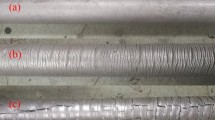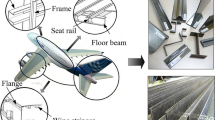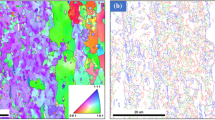Abstract
Surface cracking is one of the common problems in the extrusion process of Al–Li alloys, which seriously affects the surface quality and performance of the profile. In this study, the extrusion experiments of 2195 Al–Li alloy profiles were carried out under different temperatures and speeds to reveal the influence of extrusion parameters on the profile cracking and clarify the cracking mechanism. It was found that the extrusion cracking is closely related to the profile temperature at the die outlet and the plastic work accumulation after the material flows through the die bearing. Cracking occurs when the surface temperature of the profile is too high and the tensile plastic work accumulation exceeds the critical value. Based on the cracking mechanism, a prediction criterion for the extrusion cracking was established by taking into account the influences of deformation temperature and strain rate. The extrusion cracking of the spray-deposited 2195 Al–Li alloy profile was predicted by finite element simulation coupled with the established criteria. The predicted cracking position and degree were in good agreement with the experimental results. Finally, the boundary conditions for safe extrusion without cracking were investigated, and the extrusion limit diagram of the 2195 Al–Li alloy was constructed, which can be conveniently used to guide the selection of extrusion parameters in actual production.
















Similar content being viewed by others
Data availability
The raw/processed data required to reproduce these findings cannot be shared at this time as the data also forms part of an ongoing study.
References
Rioja R, Liu J (2012) The evolution of Al-Li base products for aerospace and space applications. Metall Mater Trans A 43(9):3325–3337. https://doi.org/10.1007/s11661-012-1155-z
El-Aty A, Xu Y, Guo X, Zhang S, Ma Y, Chen D (2018) Strengthening mechanisms, deformation behavior, and anisotropic mechanical properties of Al-Li alloys: a review. J Adv Res 10:49–67. https://doi.org/10.1016/j.jare.2017.12.004
Prasad N, Gokhale E, Wanhill R (2013) Aluminum-Lithium alloys: Processing, properties, and applications. Butterworth-Heinemann, Oxford
Atwell D, Barnett M (2007) Extrusion limits of magnesium alloys. Metall Mater Trans A 38(12):3032–3041. https://doi.org/10.1007/s11661-007-9323-2
Lapovok R, Barnett M, Davies C (2004) Construction of extrusion limit diagram for AZ31 magnesium alloy by FE simulation. J Mater Process Tech 146(3):408–414. https://doi.org/10.1016/j.jmatprotec.2003.12.003
Sheppard T, Tunnicliffe P, Patterson S (1982) Direct and indirect extrusion of a high strength aerospace alloy (AA 7075). J Mech Work Technol 6(4):313–331. https://doi.org/10.1016/0378-3804(82)90031-6
Clode M, Sheppard T (1993) Extrusion limit diagrams containing structural and topological information for AA6063 aluminium alloy. Mater Sci Tech 9(4):313–318. https://doi.org/10.1179/mst.1993.9.4.313
Tutcher M, Sheppard T (1980) Extrusion limits of Al-5Mg-0.8Mn alloy (AA5456). Metal Tech 7(12):488–493. https://doi.org/10.1179/030716980803286982
Freudenthal A (1950) The inelastic behavior of engineering materials and structures. Wiley, New York
Cockcroft M, Latham D (1968) An isotropic damage model for ductile material. J Inst Metal 96:33–39
Brozzo P, Deluca B, Rendina R (1972) A new method for the prediction of formability limits in metal sheets. Proceedings of 7th Biennal Conference of the International Deep Drawing Research Group on Sheet Metal Forming and Formability
Oh S, Chen C, Kobayashi S (1979) Ductile fracture in axisymmetric extrusion and drawing-part 2: Workability in extrusion and drawing. J Eng Ind 101(1):36–44. https://doi.org/10.1115/1.3439471
Oyane M (1972) Criteria of ductile fracture strain. Bull JSME 15(90):1507–1513. https://doi.org/10.1299/jsme1958.15.1507
Ko D, Kim B, Choi J (1996) Prediction of surface-fracture initiation in the axisymmetric extrusion and simple upsetting of an aluminum alloy. J Mater Process Tech 62(1):166–174. https://doi.org/10.1016/0924-0136(95)02200-7
Domanti A, Horrobin D, Bridgwater J (2002) An investigation of fracture criteria for predicting surface fracture in paste extrusion. Int J Mech Sci 44(7):1381–1410. https://doi.org/10.1016/S0020-7403(02)00047-4
Duan X, Velay X, Sheppard T (2004) Application of finite element method in the hot extrusion of aluminium alloys. Mat Sci Eng A 369(1–2):66–75. https://doi.org/10.1016/j.msea.2003.10.275
Peng Z, Sheppard T (2004) Study of surface cracking during extrusion of aluminium alloy AA 2014. Mater Sci Tech 20(9):1179–1191. https://doi.org/10.1179/026708304225022016
He J, Cui Z, Chen F, Xiao Y, Ruan L (2013) The new ductile fracture criterion for 30Cr2Ni4MoV ultra-super-critical rotor steel at elevated temperatures. Mater Design 52:547–555. https://doi.org/10.1016/j.matdes.2013.05.080
Zhang X, Zheng W, Shu Y, Zhou Y, Zhao Y, Wu H, Yu H (2009) Fracture criterion for predicting surface cracking of Ti40 alloy in hot forming processes. T Nonferr Metal Soc 19(2):267–271. https://doi.org/10.1016/S1003-6326(08)60263-0
Bai P, Hou X, Zhang X, Zhang C, Xing Y (2009) Microstructure and mechanical properties of a large billet of spray formed Al-Zn-Mg-Cu alloy with high Zn content. Mat Sci Eng A 508(1–2):23–27. https://doi.org/10.1016/j.msea.2008.12.010
Pu Q, Jia Z, Kong Y, Yang Q, Zhang Z, Fan X, Zhang H, Lin L, Liu Q (2020) Microstructure and mechanical properties of 2195 alloys prepared by traditional casting and spray forming. Mat Sci Eng A 784:139337. https://doi.org/10.1016/j.msea.2020.139337
Shen Y, Guan R, Zhao Z, Misra R (2015) Ultrafine-grained Al-0.2Sc-0.1Zr alloy: the mechanistic contribution of nano-sized precipitates on grain refinement during the novel process of accumulative continuous extrusion. Acta Mater 100:247–255. https://doi.org/10.1016/j.actamat.2015.08.043
Xu W, Luo Y, Fu M (2018) Microstructure evolution in the conventional single side and bobbin tool friction stir welding of thick rolled 7085–T7452 aluminum alloy. Mater Charact 138:48–55. https://doi.org/10.1016/j.matchar.2018.01.051
Zhang C, Yang S, Zhang Q, Zhao G, Lu P, Sun W (2017) Automatic optimization design of a feeder extrusion die with response surface methodology and mesh deformation technique. Int J Adv Manuf Tech 91(9–12):3181–3193. https://doi.org/10.1007/s00170-017-0018-6
Donati L, Tomesani L (2010) Friction model selection in FEM simulations of aluminium extrusion. Int J Surf Sci Eng 4(1):27–41. https://doi.org/10.1504/IJSURFSE.2010.029627
Bai S, Fang G, Zhou J (2019) Integrated physical and numerical simulations of weld seam formation during extrusion of magnesium alloy. J Mater Process Tech 266:82–95. https://doi.org/10.1016/j.jmatprotec.2018.10.025
He Y, Xie S, Chen L, Huang G, Fu Y (2010) FEM simulation of aluminum extrusion process in porthole die with pockets. T Nonferr Metal Soc 20(6):1067–1071. https://doi.org/10.1016/S1003-6326(09)60259-4
Yu J, Zhao G, Chen L (2016) Analysis of longitudinal weld seam defects and investigation of solid-state bonding criteria in porthole die extrusion process of aluminum alloy profiles. J Mater Process Tech 237:31–47. https://doi.org/10.1016/j.jmatprotec.2016.05.024
Ji H, Nie H, Chen W, Ruan X, Pan P, Zhang J (2017) Optimization of the extrusion die and microstructure analysis for a hollow aluminum alloy profile. Int J Adv Manuf Tech 93(9):3461–3471. https://doi.org/10.1007/s00170-017-0720-4
Mayavaram R, Sajja U, Secli C, Niranjan S (2013) Optimization of bearing lengths in aluminum extrusion dies. Procedia CIRP 12:276–281. https://doi.org/10.1016/j.procir.2013.09.048
Jia D, Huang X, Mo J (2012) A method to determine stress triaxiality of notched specimens from tensile tests. Chinese Conference on Computational Mechanics 2012, Chongqing
Zhao G, Yang J, Zhang R, Guo Z, Guo W, Kang C (2018) Research on the influence of stress triaxiality on fracture strain of 7075 as-cast aluminum alloy. J Plastic Eng 25(1):192–198
Kim H, Yamanaka M, Altan T (1995) Prediction and elimination of ductile fracture in cold forgings using FEM simulations. Trans N Am Manuf Res Inst SME XXIII:63–70
Lu X, Zhao G, Zhou J, Zhang C, Sun L (2018) Effect of extrusion speeds on the microstructure, texture and mechanical properties of high-speed extrudable Mg-Zn-Sn-Mn-Ca alloy. Vacuum 157:180–191. https://doi.org/10.1016/j.vacuum.2018.08.041
Kim S, Lee J, Kim Y, Moon B, You B, Kim H, Park S (2017) Improvement in extrudability and mechanical properties of AZ91 alloy through extrusion with artificial cooling. Mat Sci Eng A 703:1–8. https://doi.org/10.1016/j.msea.2017.07.048
Wang Y, Ma X, Zhao G, Xu X, Chen X, Zhang C (2021) Microstructure evolution of spray deposited and as-cast 2195 Al-Li alloys during homogenization. J Mater Sci Technol 82:161–178. https://doi.org/10.1016/j.jmst.2020.12.028
Funding
The authors would like to acknowledge the financial supports from the National Natural Science Foundation of China (Grant No. 51735008) and the Shandong Province Major Scientific and Technological Innovation Project (Grant No. 2019TSLH0102).
Author information
Authors and Affiliations
Contributions
Yongxiao Wang: conceptualization, investigation, data curation, formal analysis, methodology, writing-original draft, preparation, and submission. Guoqun Zhao: resources, project administration, funding acquisition, writing-review and editing, and supervision. Xiaoxue Chen: investigation, formal analysis, and visualization. Xiao Xu: investigation and methodology.
Corresponding author
Ethics declarations
Ethics approval
The authors hereby declare that this manuscript has not been submitted to any other journal for simultaneous consideration. The submitted work is original and has not been published elsewhere in any form or language. The results have been presented clearly, honestly, and without fabrication, falsification, or inappropriate data manipulation (including image-based manipulation). No data, text, or theories by others have been presented as if they were the author’s own (“plagiarism”). Proper acknowledgments to other works have been given, and permissions have been secured for copyrighted material.
Competing interests
The authors declare no competing interests.
Additional information
Publisher's Note
Springer Nature remains neutral with regard to jurisdictional claims in published maps and institutional affiliations.
Rights and permissions
About this article
Cite this article
Wang, Y., Zhao, G., Chen, X. et al. Cracking behavior and prediction criterion of spray-deposited 2195 Al–Li alloy extrusion profile. Int J Adv Manuf Technol 120, 5969–5984 (2022). https://doi.org/10.1007/s00170-022-09103-5
Received:
Accepted:
Published:
Issue Date:
DOI: https://doi.org/10.1007/s00170-022-09103-5




